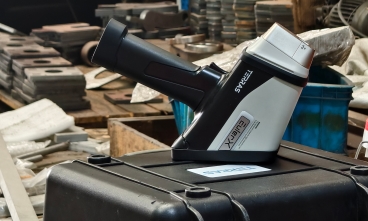
Alloy
A high-tech enterprise focusing on the development and application of X-ray technology products, committed to becoming a leading supplier of X-ray industrial testing solutions.
What is a Metal Analyzer? A Complete Guide to Its Functions and Uses
In today’s world, the importance of identifying and analyzing metals cannot be overstated. From industries that rely on the purity of metals for manufacturing to laboratories conducting precise scientific research, understanding the composition of metals plays a crucial role. One tool that has revolutionized this process is the metal analyzer. In this guide, we will explore what a metal analyzer is, its functions, types, and various uses across different sectors.
What is a Metal Analyzer?
A metal analyzer is a sophisticated tool designed to identify and analyze the chemical composition of metal alloys and other materials. These devices can detect trace elements and elements present in a sample, providing an accurate profile of the material’s composition. Metal analyzers are used in a wide range of industries, including manufacturing, construction, recycling, and quality control.
These analyzers utilize various methods such as X-ray fluorescence (XRF), optical emission spectrometry (OES), and infrared (IR) spectroscopy to provide rapid and non-destructive testing of metal samples.

How Does a Metal Analyzer Work?
The working principle of a metal analyzer depends on the type of analyzer in use. Let's break down the two most common methods used in metal analysis:
X-ray Fluorescence (XRF):
XRF analyzers use high-energy X-rays to excite the atoms in the metal. When these atoms return to their ground state, they emit secondary X-rays, known as fluorescence. The energy levels of these emitted X-rays correspond to specific elements, allowing the analyzer to identify and quantify them.
Optical Emission Spectrometry (OES):
OES works by applying an electrical charge to a metal sample, causing the metal to emit light. The emitted light is analyzed to determine the elements present and their concentrations based on the wavelengths emitted by the metal.
These methods allow for the rapid, precise analysis of metal compositions without the need to send samples to a laboratory for analysis.
Types of Metal Analyzers
Metal analyzers come in various forms, each tailored to specific applications and industries. Here are the most common types:
Handheld Metal Analyzers:
These portable devices are often used in field operations. They allow workers to quickly scan metal objects and determine their composition without the need for laboratory analysis. Handheld XRF analyzers are particularly popular in industries like construction, scrap metal recycling, and quality control in manufacturing.
Desktop Metal Analyzers:
Desktop or benchtop metal analyzers are more powerful and are typically used in labs or production settings. These devices offer a higher level of accuracy and can handle larger or more complex samples. OES analyzers often fall into this category.
Laboratory Metal Analyzers:
These are the most advanced types of metal analyzers and are used for precise research and testing. Laboratory analyzers often use a combination of techniques and are used by scientists and engineers for detailed material analysis.
Functions of a Metal Analyzer
A metal analyzer’s core function is to accurately detect and quantify the elements present in a metal alloy. Some of the primary functions of metal analyzers include:
Elemental Composition Analysis:
Metal analyzers provide a detailed breakdown of the elements present in a sample, including both major and trace elements. This is essential in determining the purity and quality of the material.
Alloy Identification:
These analyzers can identify the specific type of metal alloy present in a sample, which is vital for quality assurance and ensuring that the material meets industry standards.
Contaminant Detection:
Detecting harmful contaminants such as lead, cadmium, and other hazardous elements is crucial for ensuring the safety and compliance of materials used in manufacturing, construction, and consumer products.
Quality Control:
Manufacturers can use metal analyzers to monitor the composition of their materials in real-time. This helps to maintain consistent quality and minimize defects in the production process.
Material Recycling:
In recycling industries, metal analyzers are used to sort and classify metals. This helps in determining the best recycling processes for each type of metal, improving the efficiency and sustainability of recycling operations.
Uses of Metal Analyzers Across Industries
1. Manufacturing and Production:
In manufacturing, especially in the production of automotive parts, electronics, and aerospace components, metal analyzers are used to ensure that the materials used meet the required specifications. They help identify the right alloy mix and detect any impurities that may affect the quality of the final product.
2. Scrap Metal Recycling:
Metal analyzers play an essential role in the recycling of scrap metal. By identifying the metal types and grades, recyclers can better sort materials, ensuring that valuable metals are recovered and impurities are minimized. This process is particularly important for materials like aluminum, copper, and stainless steel.
3. Construction and Engineering:
In construction, metal analyzers are often used to verify the composition of steel and other alloys used in structural components. Ensuring the correct composition is crucial for safety and durability.
4. Aerospace and Defense:
In these highly regulated industries, ensuring the purity and specific alloy content of metals used in parts like engines, fuselages, and weapons is critical. Metal analyzers are used to monitor and verify these materials for compliance with strict standards.
5. Research and Development:
In laboratories, metal analyzers are used for scientific research and material testing. Engineers and scientists use them to study the properties of new alloys and metals, developing advanced materials for new technologies.
6. Environmental Protection:
Metal analyzers are also used in environmental testing to detect heavy metals in soil, water, and air. This helps to monitor pollution levels and ensure compliance with environmental standards.

Terras EulerX900 Handheld Alloy Analyzer
Advantages of Metal Analyzers
Non-destructive Testing: Many metal analyzers can analyze a sample without causing any damage, allowing the sample to be reused or repurposed.
Portability: Handheld analyzers provide mobility, making it easier for workers to perform tests on-site.
Quick Results: Metal analyzers deliver results in minutes, improving efficiency and decision-making processes.
Cost-Effective: Reducing the need for laboratory testing, these devices save both time and money, especially in industries that require frequent testing.
High Precision: With advanced technology, metal analyzers provide highly accurate results, ensuring the quality and safety of materials used in manufacturing and production.
XRF spectrometry, introduced decades ago, is a well-established and widely adopted method for metal analysis, valued for its portability, user-friendliness, and minimal maintenance. It serves as a reliable quality control solution in metal processing plants. The EulerX 900 series handheld alloy analyzers are commonly used for tasks such as alloy verification, scrap sorting, precious metal testing, and PMI, with applications covering solids, liquids, and powders.
Conclusion
Metal analyzers have become indispensable tools across various industries, offering quick, accurate, and cost-effective solutions for determining the composition of metals. Whether in manufacturing, research, recycling, or quality control, these devices ensure that materials meet the required standards and help companies maintain product quality and compliance. With continued advancements in technology, metal analyzers will only become more powerful, furthering their usefulness and importance in various industries.
Join Us
Subscribe to our email list for updates & promotions.



